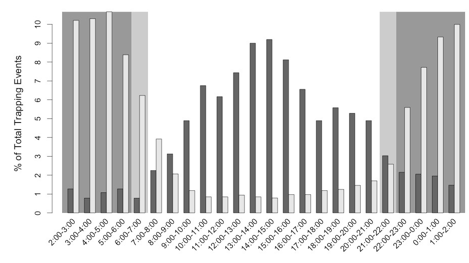


Przewalski's horses were reintroduced in Kalamaili more than 10 years ago. Following their ancestors’ path, they are trying to adapt to this arid landscape, as well as learning how to face the existence of their relatives, thousands of Asiatic wild asses.
Two equids face the similar changes of water and food shortages and their resource use strategies will affect the coexistence of themselves. We have been using the camera traps and observations/vegetation samplings to study their water and forage selections, while applying the GPS/satellite collars to study their displacement in space and time.


Temporal heterogeneity of two equids’ water use, the Przewalski’s horse (dark) and the Asiatic wild ass (light), from our camera trap data.
Animal movements are fascinating. We have been focusing on movement ecology, especially the orientation mechanisms, movement drivers, and population distribution dynamics.
Since 2006, we have been working on the satellite tracking of the released horses, in order to provide the real time relocation information for the monitoring, and to understand their habitat and resource selections to facilitate the future release. Currently, we are focusing on the effects of vegetation and precipitation to the movement dynamics of the released horses.
In 2012 and 2013, we are going to collar 5 Asiatic wild asses, in order to form the rational comparison of the movement strategies and habitat choices between two sympatric equids.

